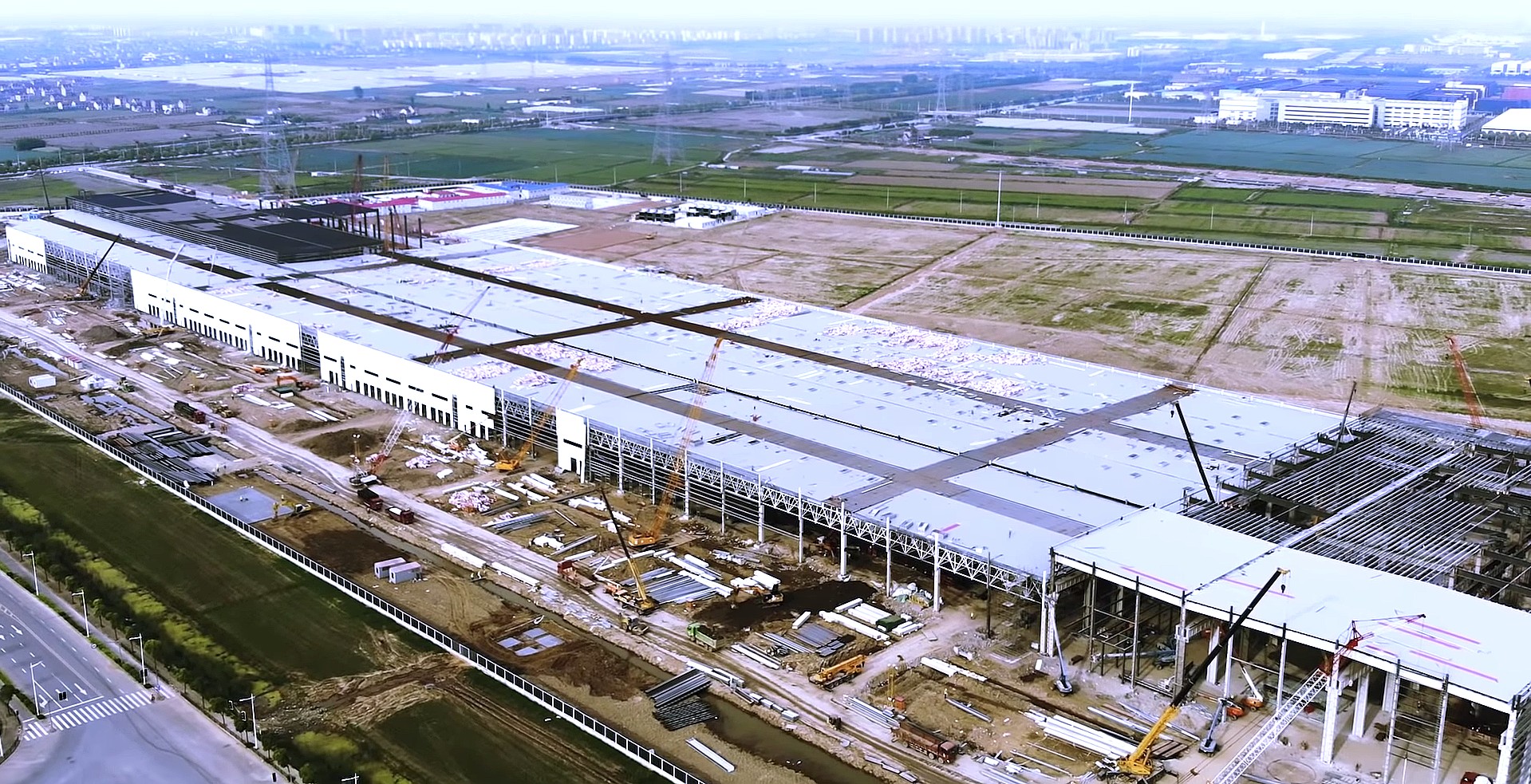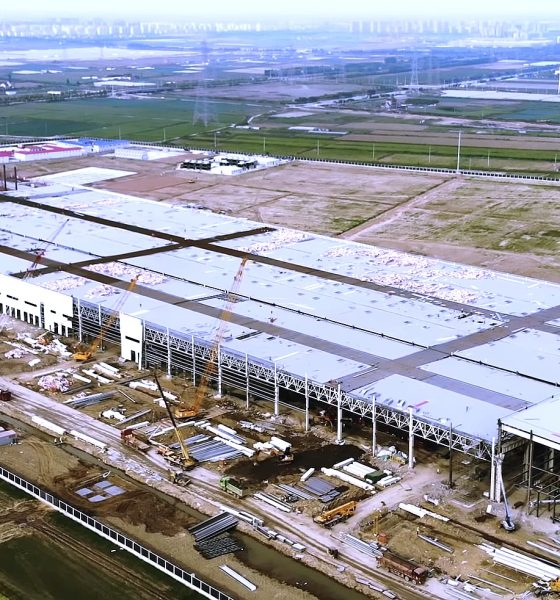

News
Tesla Gigafactory 3 is what happens when Elon Musk’s vision is taken seriously
To say that the buildout of Tesla’s Gigafactory 3 in China is fast is a gross understatement. Within a few months, Tesla’s 864,885-square meter lot in Shanghai’s Lingang Industrial Area has been transformed from a large, muddy field into a site where a massive electric car factory is taking shape. Every update of Gigafactory 3 shows the facility making visible progress. This week alone, footage from the site revealed that workers have practically completed the roof of Tesla’s general assembly building, and walls are already being set built.
Back in March, Shanghai official Chen Mingbo stated that the initial buildout of the factory should be completed by May. Considering the speed of the facility’s construction, this insane timeframe seems to be on track. If this target is accomplished, Tesla could start Model 3 trial production as early as September. That’s significantly ahead of Elon Musk’s own estimates, which pointed to initial production starting near the end of 2019. Reports from China also indicate that Gigafactory 3 could set a record for fastest factory buildout in the country.
The original timeline for Gigafactory 3 was actually far more conservative, with Tesla noting that it expected vehicle manufacturing to start roughly two years after construction begins. The timeframe, which was classic Elon Musk in the way that it is optimistic and ambitious, faced relentless skepticism in the United States. Consumer Edge Research senior auto analyst James Albertine, in a segment of Bloomberg Markets, flat-out stated that Tesla’s targets for Gigafactory 3’s construction were simply “not feasible.”
The reaction to Gigafactory 3’s initial timetable is quite reflective of the amount of skepticism and criticism thrown at Tesla and Elon Musk on a rather consistent basis. In the United States, Musk pretty much faces opposition at every turn. It is not uncommon to see reports about Tesla having a negative slant. People betting on Tesla’s failure such as short-sellers consistently accuse Musk of being a fraud as well, while mocking him on social media platforms such as Twitter for his alleged shortcomings. One particularly passionate short-seller actually received a restraining order after allegedly trespassing, harassing, and causing harm to Tesla employees.
With the drama surrounding Tesla, it is no wonder that Elon Musk wanted to take the company private last year. When Musk pitched the idea to investors, he argued that it would be a lot easier for Tesla to pursue its goals if it could operate without the short-term pressures of Wall St and the constant barrage of noise from critics that stand to receive financial gain if the electric car maker were to fall. The take-private attempt ultimately fell through after Elon Musk backed out of a ~$30 billion deal from investors that included Volkswagen AG. In the Q1 2019 earnings call, the CEO noted that a non-public Tesla will not be happening anytime soon. “Unfortunately, that ship had sailed,” Musk said.
It could be said that the nearly unbelievable pace of Gigafactory 3’s construction is what happens when Elon Musk’s ambitious vision is embraced without noise or unnecessary drama. There were no controversies among China’s workforce when Elon Musk noted that he expects electric car production to begin by the end of the year. Instead, the company’s construction partner took the CEO’s ambitious timeframe seriously and did what was necessary to build Gigafactory 3 as quickly as possible, including adopting 24/7 work. Going a step further, the country even pursued a target completion date that exceeds Elon Musk’s already ambitious timeframe. Today, Model 3 trial production is expected to start as early as September.
If there is a lesson that can be learned from Gigafactory 3, it is that visionaries such as Elon Musk could accomplish great things if their targets are supported and taken seriously. This is something that China seems to be all too willing to give Elon Musk, as could be seen when he met with Chinese Premier Li Keqiang in Beijing last January. During his meeting with Li, Musk acted like his usual self, throwing out grand ideas about Gigafactory 3 and mentioning his vision of creating a facility that acts almost like a “living being.” Li proved quite open to Musk’s ideas, even offering the CEO a ‘Chinese Green Card’ so he could openly pursue his plans in the country.
Demonstrating this point, here’s the Gigafactory 3 site in early March.
And here’s a flyby of Gigafactory 3 on May 7, 2019, roughly two months later.

News
Tesla starts showing how FSD will change lives in Europe
Local officials tested the system on narrow country roads and were impressed by FSD’s smooth, human-like driving, with some calling the service a game-changer for everyday life in areas that are far from urban centers.

Tesla has launched Europe’s first public shuttle service using Full Self-Driving (Supervised) in the rural Eifelkreis Bitburg-Prüm region of Germany, demonstrating how the technology can restore independence and mobility for people who struggle with limited transport options.
Local officials tested the system on narrow country roads and were impressed by FSD’s smooth, human-like driving, with some calling the service a game-changer for everyday life in areas that are far from urban centers.
Officials see real impact on rural residents
Arzfeld Mayor Johannes Kuhl and District Administrator Andreas Kruppert personally tested the Tesla shuttle service. This allowed them to see just how well FSD navigated winding lanes and rural roads confidently. Kruppert said, “Autonomous driving sounds like science fiction to many, but we simply see here that it works totally well in rural regions too.” Kuhl, for his part, also noted that FSD “feels like a very experienced driver.”
The pilot complements the area’s “Citizen Bus” program, which provides on-demand rides for elderly residents who can no longer drive themselves. Tesla Europe shared a video of a demonstration of the service, highlighting how FSD gives people their freedom back, even in places where public transport is not as prevalent.
What the Ministry for Economic Affairs and Transport says
Rhineland-Palatinate’s Minister Daniela Schmitt supported the project, praising the collaboration that made this “first of its kind in Europe” possible. As per the ministry, the rural rollout for the service shows FSD’s potential beyond major cities, and it delivers tangible benefits like grocery runs, doctor visits, and social connections for isolated residents.
“Reliable and flexible mobility is especially vital in rural areas. With the launch of a shuttle service using self-driving vehicles (FSD supervised) by Tesla in the Eifelkreis Bitburg-Prüm, an innovative pilot project is now getting underway that complements local community bus services. It is the first project of its kind in Europe.
“The result is a real gain for rural mobility: greater accessibility, more flexibility and tangible benefits for everyday life. A strong signal for innovation, cooperation and future-oriented mobility beyond urban centers,” the ministry wrote in a LinkedIn post.
News
Tesla China quietly posts Robotaxi-related job listing
Tesla China is currently seeking a Low Voltage Electrical Engineer to work on circuit board design for the company’s autonomous vehicles.

Tesla has posted a new job listing in Shanghai explicitly tied to its Robotaxi program, fueling speculation that the company is preparing to launch its dedicated autonomous ride-hailing service in China.
As noted in the listing, Tesla China is currently seeking a Low Voltage Electrical Engineer to work on circuit board design for the company’s autonomous vehicles.
Robotaxi-specific role
The listing, which was shared on social media platform X by industry watcher @tslaming, suggested that Tesla China is looking to fill the role urgently. The job listing itself specifically mentions that the person hired for the role will be working on the Low Voltage Hardware team, which would design the circuit boards that would serve as the nervous system of the Robotaxi.
Key tasks for the role, as indicated in the job listing, include collaboration with PCB layout, firmware, mechanical, program management, and validation teams, among other responsibilities. The role is based in Shanghai.
China Robotaxi launch
China represents a massive potential market for robotaxis, with its dense urban centers and supportive policies in select cities. Tesla has limited permission to roll out FSD in the country, though despite this, its vehicles have been hailed as among the best in the market when it comes to autonomous features. So far, at least, it appears that China supports Tesla’s FSD and Robotaxi rollout.
This was hinted at in November, when Tesla brought the Cybercab to the 8th China International Import Expo (CIIE) in Shanghai, marking the first time that the autonomous two-seater was brought to the Asia-Pacific region. The vehicle, despite not having a release date in China, received a significant amount of interest among the event’s attendees.
Elon Musk
Elon Musk and Tesla AI Director share insights after empty driver seat Robotaxi rides
The executives’ unoccupied tests hint at the rapid progress of Tesla’s unsupervised Robotaxi efforts.

Tesla CEO Elon Musk and AI Director Ashok Elluswamy celebrated Christmas Eve by sharing personal experiences with Robotaxi vehicles that had no safety monitor or occupant in the driver’s seat. Musk described the system’s “perfect driving” around Austin, while Elluswamy posted video from the back seat, calling it “an amazing experience.”
The executives’ unoccupied tests hint at the rapid progress of Tesla’s unsupervised Robotaxi efforts.
Elon and Ashok’s firsthand Robotaxi insights
Prior to Musk and the Tesla AI Director’s posts, sightings of unmanned Teslas navigating public roads were widely shared on social media. One such vehicle was spotted in Austin, Texas, which Elon Musk acknowleged by stating that “Testing is underway with no occupants in the car.”
Based on his Christmas Eve post, Musk seemed to have tested an unmanned Tesla himself. “A Tesla with no safety monitor in the car and me sitting in the passenger seat took me all around Austin on Sunday with perfect driving,” Musk wrote in his post.
Elluswamy responded with a 2-minute video showing himself in the rear of an unmanned Tesla. The video featured the vehicle’s empty front seats, as well as its smooth handling through real-world traffic. He captioned his video with the words, “It’s an amazing experience!”
Towards Unsupervised operations
During an xAI Hackathon earlier this month, Elon Musk mentioned that Tesla owed be removing Safety Monitors from its Robotaxis in Austin in just three weeks. “Unsupervised is pretty much solved at this point. So there will be Tesla Robotaxis operating in Austin with no one in them. Not even anyone in the passenger seat in about three weeks,” he said. Musk echoed similar estimates at the 2025 Annual Shareholder Meeting and the Q3 2025 earnings call.
Considering the insights that were posted Musk and Elluswamy, it does appear that Tesla is working hard towards operating its Robotaxis with no safety monitors. This is quite impressive considering that the service was launched just earlier this year.








